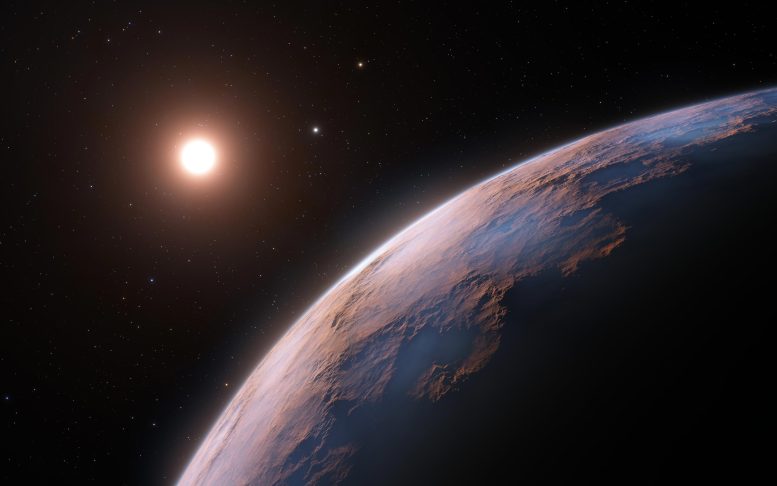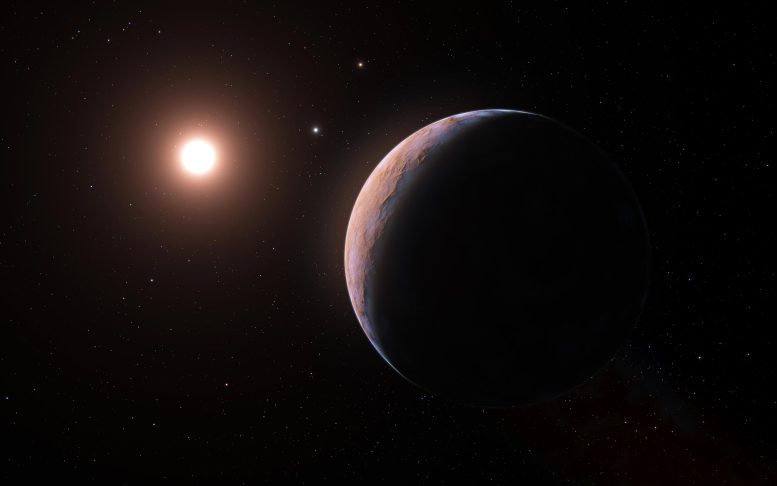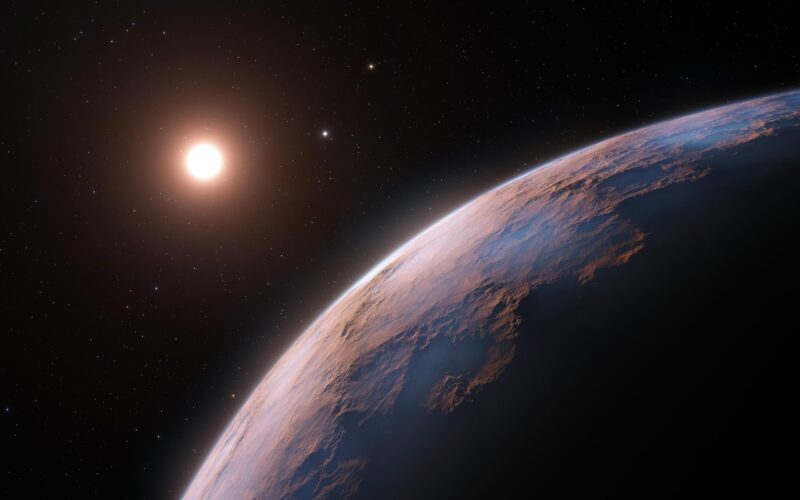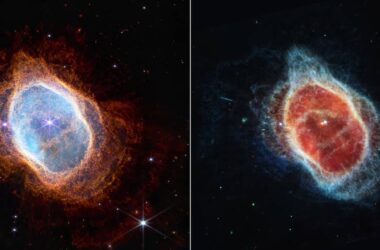
Cette impression d’artiste montre une vue rapprochée de Proxima d, une planète candidate récemment découverte en orbite autour de l’étoile naine rouge Proxima Centauri, l’étoile la plus proche du système solaire. On pense que la planète est rocheuse et qu’elle a une masse d’environ un quart de celle de la Terre. Deux autres planètes connues en orbite autour de Proxima Centauri sont également visibles sur l’image : Proxima b, une planète ayant à peu près la même masse que la Terre, qui tourne autour de l’étoile tous les 11 jours et se trouve dans la zone habitable, et la candidate Proxima c, qui est sur une orbite plus longue de cinq ans autour de l’étoile. Crédit : ESO/L. Calçada
Une équipe d’astronomes utilisant le Very Large Telescope (ESO’s VLT) in Chile have found evidence of another planet orbiting Proxima Centauri, the closest star to our Solar System. This candidate planet is the third detected in the system and the lightest yet discovered orbiting this star. At just a quarter of Earth’s mass, the planet is also one of the lightest exoplanets ever found.
“The discovery shows that our closest stellar neighbor seems to be packed with interesting new worlds, within reach of further study and future exploration,” explains João Faria, a researcher at the Instituto de Astrofísica e Ciências do Espaço, Portugal and lead author of the study published today in Astronomy & Astrophysics. Proxima Centauri is the closest star to the Sun, lying just over four light-years away.
La planète nouvellement découverte, nommée Proxima d, tourne autour de Proxima Centauri à une distance d’environ quatre millions de kilomètres, soit moins d’un dixième de la distance de Mercure au Soleil. Elle orbite entre l’étoile et la zone habitable – la zone autour d’une étoile où l’eau liquide peut exister à la surface d’une planète – et ne met que cinq jours pour effectuer une orbite autour de Proxima du Centaure.
L’étoile est déjà connue pour abriter deux autres planètes : Proxima b, une planète d’une masse comparable à celle de la Terre qui tourne autour de l’étoile tous les 11 jours et se trouve dans la zone habitable, et la candidate Proxima c, qui est sur une orbite plus longue de cinq ans autour de l’étoile.

Cette impression d’artiste montre Proxima d, une planète candidate récemment découverte en orbite autour de l’étoile naine rouge Proxima Centauri, l’étoile la plus proche du système solaire. On pense que la planète est rocheuse et qu’elle a une masse d’environ un quart de celle de la Terre. Deux autres planètes connues en orbite autour de Proxima Centauri sont également visibles sur l’image : Proxima b, une planète d’environ la même masse que la Terre qui tourne autour de l’étoile tous les 11 jours et se trouve dans la zone habitable, et la candidate Proxima c, qui est sur une orbite plus longue de cinq ans autour de l’étoile. Crédit : ESO/L. Calçada
Proxima b a été découverte il y a quelques années grâce au HARPS instrument on ESO’s 3.6-meter telescope. The discovery was confirmed in 2020 when scientists observed the Proxima system with a new instrument on ESO’s VLT that had greater precision, the Echelle SPectrograph for Rocky Exoplanets and Stable Spectroscopic Observations (ESPRESSO). It was during these more recent VLT observations that astronomers spotted the first hints of a signal corresponding to an object with a five-day orbit. As the signal was so weak, the team had to conduct follow-up observations with ESPRESSO to confirm that it was due to a planet, and not simply a result of changes in the star itself.
“After obtaining new observations, we were able to confirm this signal as a new planet candidate,” Faria says. “I was excited by the challenge of detecting such a small signal and, by doing so, discovering an exoplanet so close to Earth.”

This chart shows the large southern constellation of Centaurus (The Centaur) and shows most of the stars visible with the naked eye on a clear dark night. The location of the closest star to the Solar System, Proxima Centauri, is marked with a red circle. Proxima is too faint to see with the unaided eye but can be found using a small telescope. Credit: ESO/IAU and Sky & Telescope
At just a quarter of the mass of Earth, Proxima d is the lightest exoplanet ever measured using the radial velocity technique, surpassing a planet recently discovered in the L 98-59 planetary system. The technique works by picking up tiny wobbles in the motion of a star created by an orbiting planet’s gravitational pull. The effect of Proxima d’s gravity is so small that it only causes Proxima Centauri to move back and forth at around 40 centimeters per second (1.44 kilometers per hour).
“This achievement is extremely important,” says Pedro Figueira, ESPRESSO instrument scientist at ESO in Chile. “It shows that the radial velocity technique has the potential to unveil a population of light planets, like our own, that are expected to be the most abundant in our galaxy and that can potentially host life as we know it.”

This image of the sky around the bright star Alpha Centauri AB also shows the much fainter red dwarf star, Proxima Centauri, the closest star to the Solar System. The picture was created from pictures forming part of the Digitized Sky Survey 2. The blue halo around Alpha Centauri AB is an artifact of the photographic process, the star is really pale yellow in color like the Sun. Credit: Digitized Sky Survey 2, Acknowledgement: Davide De Martin/Mahdi Zamani
“This result clearly shows what ESPRESSO is capable of and makes me wonder about what it will be able to find in the future,” Faria adds.
ESPRESSO’s search for other worlds will be complemented by ESO’s Extremely Large Telescope (ELT), currently under construction in the Atacama Desert, which will be crucial to discovering and studying many more planets around nearby stars.
Reference: “A candidate short-period sub-Earth orbiting Proxima Centauri” 10 February 2022, Astronomy & Astrophysics.
DOI: 10.1051/0004-6361/202142337
The team is composed of J. P. Faria (Instituto de Astrofísica e Ciências do Espaço, Universidade do Porto, Portugal [IA/UPorto], Centro de Astrofísica da Universidade do Porto, Portugal [CAUP] et le Departamento de Física e Astronomia, Faculdade de Ciências, Universidade do Porto, Portugal. [FCUP]), A. Suárez Mascareño (Instituto de Astrofísica de Canarias, Tenerife, Espagne [IAC]).[IAC], Departamento de Astrofísica, Universidad de La Laguna, Tenerife, Espagne [IAC-ULL]), P. Figueira (Observatoire européen austral, Santiago, Chili [ESO-Chile]).[ESO-Chile]IA-Porto), A. M. Silva (IA-Porto, FCUP), M. Damasso (Osservatorio Astrofisico di Torino, Italie [INAF-Turin]).[INAF-Turin]), O. Demangeon (IA-Porto, FCUP), F. Pepe (Département d’astronomie de l’Université de Genève, Suisse). [UNIGE]), N. C. Santos (IA-Porto, FCUP), R. Rebolo (Consejo Superior de Investigaciones Científicas, Madrid, Espagne). [CSIC], IAC-ULL, IAC), S. Cristiani (INAF – Osservatorio Astronomico di Trieste, Italy [OATS]), V. Adibekyan (IA-Porto), Y. Alibert (Institut de Physique de l Université de BerneSuisse), R. Allart (Département de physique, et Institut de recherche sur les exoplanètes, Université de Montréal, Canada, UNIGE), S. C. C. Barros (IA-Porto, FCUP), A. Cabral (Instituto de Astrofísica e Ciências do Espaço, Faculdade de Ciências da Universidade de Lisboa, Portugal [IA-Lisboa], Faculdade de Ciências da Universidade de Lisboa, Portugal [FCUL]), V. D’Odorico (OATS, Institut de Physique Fondamentale de l’Univers, Trieste, Italie [IFPU], Scuola Normale Superiore, Pise, Italie) P. Di Marcantonio (OATS), X. Dumusque (UNIGE), D. Ehrenreich (UNIGE), J. I. GonzálezHernández (IAC-ULL, IAC), N. Hara (UNIGE), J. Lillo-Box (Centro de Astrobiología (CAB, CSIC-INTA), Depto. de Astrofísica, Madrid, Spain), G. Lo Curto (European Southern Observatory, Garching bei München, Germany) [ESO], ESO-Chile) C. Lovis (UNIGE), C. J. A. P. Martins (IA-Porto, Centro de Astrofísica da Universidade do Porto, Portugal), D. Mégevand (UNIGE), A. Mehner (ESO-Chile), G. Micela (INAF – Osservatorio Astronomico di Palermo, Italie), P. Molaro (OATS), IFPU), N. J. Nunes (IA-Lisboa), E. Pallé (IAC, IAC-ULL), E. Poretti (INAF – Osservatorio Astronomico di Brera, Merate, Italie ), S. G. Sousa (IA-Porto, FCUP), A. Sozzetti (INAF-Turin), H. Tabernero (Centro de Astrobiología, Madrid, Espagne). [CSIC-INTA]), S. Udry (UNIGE), et M. R. Zapatero Osorio (CSIC-INTA).



